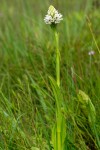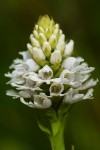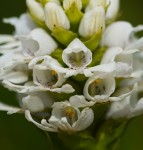| Home | > | List of families | > | Orchidaceae | > | Satyrium | > | paludosum |
Satyrium paludosum
Selected images: Click on each image to see a larger version and details of the record View all images (3)
Detailed records: Display species records QDS maps by: Google Maps Point records by Google Maps
Species details: Click on each item to see an explanation of that item (Note: opens a new window)
| Synonyms: | |
| Common names: | |
| Frequency: | |
| Status: | Native |
| Description: |
Robust terrestrial herb 30–90 cm high; tubers ellipsoid, up to 2.5 cm long, hairy. Leaves 5–11 along the stem, lowermost 2–3 sheathing, the rest semi-erect, lanceolate, ribbed, 12–27 cm long, decreasing in size towards stem apex. Inflorescence pyramidal, 3–6 cm long, densely many-flowered. Flowers white, often with purple marks at base of petals and inside lip; bracts erect, up to 26 mm long, pale green. Sepals and petals projecting forwards, joined in basal half or third. Median sepal ligulate, 9–11 mm long; lateral sepals of similar length but about twice as wide, oblique. Petals similar to median sepal but slightly shorter and narrower. Lip 8.5–14 mm long, very convex with a projecting apex, wide-mouthed, hairy inside at base. Spurs saccate, 1–2.5 mm long, sometimes almost absent. |
| Notes: | |
| Derivation of specific name: | paludosum: of marshy places. |
| Habitat: | Montane and boggy grassland. |
| Altitude range: (metres) | 1300 - 2200 m |
| Flowering time: | Nov - Feb |
| Worldwide distribution: | Angola, DRC, Kenya, Malawi, Zambia and Zimbabwe. |
| Zimbabwe distribution: | C,E |
| Growth form(s): | |
| Endemic status: | |
| Red data list status: | |
| Insects associated with this species: | |
| Spot characters: | Display spot characters for this species |
| Images last updated: | Sunday 6 January 2019 |
| Literature: |
Chapano, C. & Mamuto, M. (2003). Plants of the Chimanimani District National Herbarium and Botanic Garden, Zimbabwe Page 49. Fibeck, W. & Dare, M. (1993). Terrestrial Orchids in Zimbabwe. Excelsa 16 Page 70. Grosvenor, R.K. (1976). A list of orchids indigenous in Rhodesia. Excelsa 6 Page 85. La Croix, I. & Cribb, P.J. (1995). Orchidaceae (Part 1) Flora Zambesiaca 11(1) Pages 223 - 224. La Croix, I. et al. (1991). Orchids of Malawi A.A. Balkema, Rotterdam Page 149. (Includes a picture). Mapaura, A. & Timberlake, J. (eds) (2004). A checklist of Zimbabwean vascular plants Southern African Botanical Diversity Network Report No. 33 Sabonet, Pretoria and Harare Page 98. Phiri, P.S.M. (2005). A Checklist of Zambian Vascular Plants Southern African Botanical Diversity Network Report No. 32 Page 124. Stewart, J. & Campbell, B. (1996). Orchids of Kenya Timber Press Inc, Portland Oregon, USA ISBN0-88192-357-5 Pages 157 - 158. (Includes a picture). Williamson, G. (1977). The Orchids of South Central Africa J.M. Dent & Sons Ltd., London. Pages 98 - 99. (Includes a picture). |
Other sources of information about Satyrium paludosum:
Our websites:
Flora of Malawi: Satyrium paludosumFlora of Zambia: Satyrium paludosum
External websites:
African Plants: A Photo Guide (Senckenberg): Satyrium paludosumAfrican Plant Database: Satyrium paludosum
BHL (Biodiversity Heritage Library): Satyrium paludosum
EOL (Encyclopedia of Life): Satyrium paludosum
GBIF (Global Biodiversity Information Facility): Satyrium paludosum
Google: Web - Images - Scholar
iNaturalist: Satyrium paludosum
IPNI (International Plant Names Index): Satyrium paludosum
JSTOR Plant Science: Satyrium paludosum
Mansfeld World Database of Agricultural and Horticultural Crops: Satyrium paludosum
Plants of the World Online: Satyrium paludosum
Tropicos: Satyrium paludosum
Wikipedia: Satyrium paludosum
| Home | > | List of families | > | Orchidaceae | > | Satyrium | > | paludosum |


